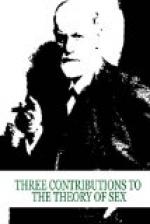it were, the negative of the perversion. In view
of the now recognized great diffusion of tendencies
to perversion the idea forced itself upon us that the
disposition to perversions is the primitive and universal
disposition of the human sexual impulse, from which
the normal sexual behavior develops in consequence
of organic changes and psychic inhibitions in the course
of maturity. We hoped to be able to demonstrate
the original disposition in the infantile life; among
the forces restraining the direction of the sexual
impulse we have mentioned shame, loathing and sympathy,
and the social constructions of morality and authority.
We have thus been forced to perceive in every fixed
aberration from the normal sexual life a fragment
of inhibited development and infantilism. The
significance of the variations of the original dispositions
had to be put into the foreground, but between them
and the influences of life we had to assume a relation
of cooeperation and not of opposition. On the
other hand, as the original disposition must have
been a complex one, the sexual impulse itself appeared
to us as something composed of many factors, which
in the perversions becomes separated, as it were, into
its components. The perversions, thus prove themselves
to be on the one hand inhibitions, and on the other
dissociations from the normal development. Both
conceptions became united in the assumption that the
sexual impulse of the adult due to the composition
of the diverse feelings of the infantile life became
formed into one unit, one striving, with one single
aim.
We also added an explanation for the preponderance
of perversive tendencies in the psychoneurotics by
recognizing in these tendencies collateral fillings
of side branches caused by the shifting of the main
river bed through repression, and we then turned our
examination to the sexual life of the infantile period.[12]
We found it regrettable that the existence of a sexual
life in infancy has been disputed, and that the sexual
manifestations which have been often observed in children
have been described as abnormal occurrences. It
rather seemed to us that the child brings along into
the world germs of sexual activity and that even while
taking nourishment it at the same time also enjoys
a sexual gratification which it then seeks again to
procure for itself through the familiar activity of
“thumbsucking.” The sexual activity
of the child, however, does not develop in the same
measure as its other functions, but merges first into
the so-called latency period from the age of three
to the age of five years. The production of sexual
excitation by no means ceases at this period but continues
and furnishes a stock of energy, the greater part
of which is utilized for aims other than sexual; namely,
on the one hand for the delivery of sexual components
for social feelings, and on the other hand (by means
of repression and reaction formation) for the erection
of the future sexual barriers. Accordingly, the




